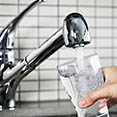Assessing the Vulnerability of Maine’s Drinking Water Resources to Extreme Precipitation Events
 Institution: University of Maine
Institution: University of Maine
Sponsor: Maine Water Resources Research Institute through the Mitchell Center
As our climate changes, so do extreme rain and snow events, which have increased in frequency in the Northeastern U.S. by more than 50 percent since the 1950s. For example, on September 30, 2015, Bangor received 5.27 inches of rain in one day. This increase in the rate and intensity of precipitation events and associated rapid runoff is threatening Maine’s high-quality water supplies—more than half of which come from 46 lakes dotted around the state.
These extreme events wash organic matter into lakes that can ultimately cause a build up of what’s called “organic carbon,” some of which is in solution as dissolved organic carbon, or DOC for short. Increased DOC can trigger algal blooms, taste and odor problems, and may form by-products. Many water utilities in Maine have expressed concern about these potential problems.
Now, with support from the Maine Water Resources Research Institute (WRRI) at the University of Maine, researchers are taking an integrated approach to assess both the ecological and economic vulnerability of Maine’s drinking water lakes—and the communities dependent on them—when these extreme events occur.
Currently, the extent to which changing precipitation is altering the type and quantity of DOC, and consequently the quality of Maine’s lakes, is unclear. Moreover, little is known about the economic costs associated with potential changes in water quality, which pose health threats and expensive remediation strategies. This lack of data makes it difficult for managers to determine the appropriate strategies needed to sustain drinking water quality.
WRRI project scientists will quantify changes in DOC concentration and quality to identify the immediate response of lakes to storms. This will aid in determining what remediation efforts might be required by drinking water utilities in the wake of such storms and help quantify short-term economic costs related to filtration and treatment infrastructure.
“In the longer term, this research will inform implications of storm events on drinking water sources and the development of management and adaptation strategies to ensure sustained high water quality,” said WRRI project scientist Jasmine Saros.
Team Members:
- Jasmine E. Saros, School of Biology and Ecology and Climate Change Institute, University of Maine
- Kathryn Warner, Climate Change Institute, University of Maine
